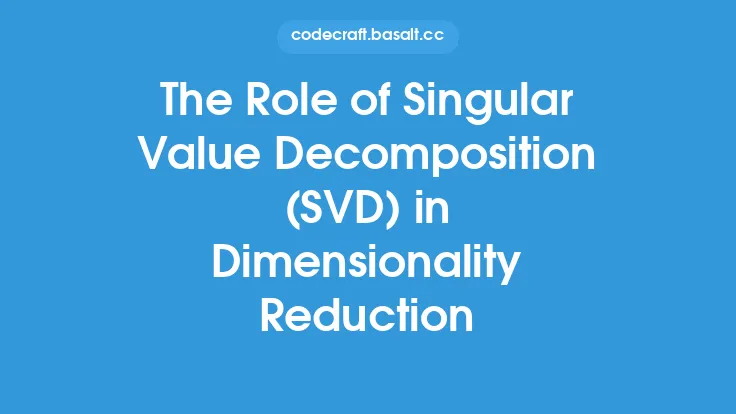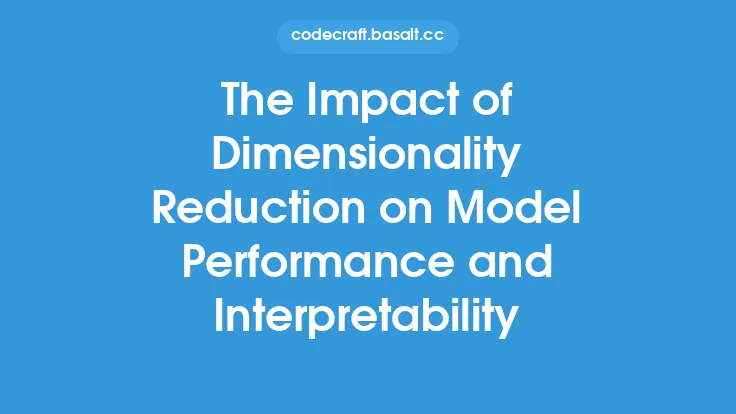Principal Component Analysis (PCA) is a widely used dimensionality reduction technique in machine learning that transforms high-dimensional data into lower-dimensional data while retaining most of the information. The goal of PCA is to identify the principal components, or the directions of maximum variance, in the data and project the data onto these components. This results in a lower-dimensional representation of the data that captures the most important features.
What is Principal Component Analysis?
PCA is a linear dimensionality reduction technique that works by finding the eigenvectors and eigenvalues of the covariance matrix of the data. The eigenvectors represent the directions of maximum variance in the data, and the eigenvalues represent the amount of variance explained by each eigenvector. By selecting the top k eigenvectors, corresponding to the k largest eigenvalues, PCA reduces the dimensionality of the data from n features to k features.
How Does PCA Work?
The PCA algorithm involves the following steps:
- Data Standardization: The data is standardized by subtracting the mean and dividing by the standard deviation for each feature. This ensures that all features are on the same scale and prevents features with large ranges from dominating the analysis.
- Covariance Matrix Calculation: The covariance matrix is calculated from the standardized data. The covariance matrix represents the variance and covariance between each pair of features.
- Eigenvector and Eigenvalue Calculation: The eigenvectors and eigenvalues are calculated from the covariance matrix. The eigenvectors represent the directions of maximum variance, and the eigenvalues represent the amount of variance explained by each eigenvector.
- Sorting and Selecting Eigenvectors: The eigenvectors are sorted in descending order of their corresponding eigenvalues, and the top k eigenvectors are selected.
- Projection: The original data is projected onto the selected eigenvectors to obtain the lower-dimensional representation.
Types of PCA
There are several types of PCA, including:
- Standard PCA: This is the most common type of PCA, which uses the covariance matrix to calculate the eigenvectors and eigenvalues.
- Robust PCA: This type of PCA is used for data with outliers or noise. It uses a robust estimation method to calculate the covariance matrix.
- Sparse PCA: This type of PCA is used for high-dimensional data with a small number of features. It uses a sparse regularization technique to select the most important features.
- Kernel PCA: This type of PCA is used for non-linear data. It uses a kernel function to map the data into a higher-dimensional space, where PCA is applied.
Advantages of PCA
PCA has several advantages, including:
- Reducing dimensionality: PCA reduces the dimensionality of the data, making it easier to visualize and analyze.
- Retaining information: PCA retains most of the information in the data, making it a useful technique for data compression.
- Improving model performance: PCA can improve the performance of machine learning models by reducing overfitting and improving generalization.
- Identifying correlations: PCA can identify correlations between features, making it a useful technique for feature selection.
Disadvantages of PCA
PCA also has several disadvantages, including:
- Linearity assumption: PCA assumes that the data is linear, which may not always be the case.
- Sensitive to outliers: PCA is sensitive to outliers, which can affect the accuracy of the results.
- Difficult to interpret: PCA can be difficult to interpret, especially for high-dimensional data.
- Not suitable for non-linear data: PCA is not suitable for non-linear data, which may require non-linear dimensionality reduction techniques.
Real-World Applications of PCA
PCA has several real-world applications, including:
- Image compression: PCA can be used to compress images by reducing the dimensionality of the pixel data.
- Text analysis: PCA can be used to analyze text data by reducing the dimensionality of the word frequencies.
- Gene expression analysis: PCA can be used to analyze gene expression data by reducing the dimensionality of the gene expression levels.
- Customer segmentation: PCA can be used to segment customers based on their demographic and behavioral characteristics.
Common PCA Algorithms
There are several common PCA algorithms, including:
- NIPALS: NIPALS (Non-linear Iterative Partial Least Squares) is a PCA algorithm that uses an iterative approach to calculate the eigenvectors and eigenvalues.
- Power iteration: Power iteration is a PCA algorithm that uses an iterative approach to calculate the eigenvectors and eigenvalues.
- QR algorithm: QR algorithm is a PCA algorithm that uses a QR decomposition approach to calculate the eigenvectors and eigenvalues.
PCA Implementation in Python
PCA can be implemented in Python using the following libraries:
- Scikit-learn: Scikit-learn is a machine learning library that provides a PCA implementation.
- NumPy: NumPy is a numerical library that provides functions for calculating the eigenvectors and eigenvalues.
- SciPy: SciPy is a scientific library that provides functions for calculating the eigenvectors and eigenvalues.
Conclusion
PCA is a widely used dimensionality reduction technique that transforms high-dimensional data into lower-dimensional data while retaining most of the information. It has several advantages, including reducing dimensionality, retaining information, improving model performance, and identifying correlations. However, it also has several disadvantages, including linearity assumption, sensitivity to outliers, difficulty in interpretation, and not being suitable for non-linear data. PCA has several real-world applications, including image compression, text analysis, gene expression analysis, and customer segmentation. It can be implemented in Python using libraries such as scikit-learn, NumPy, and SciPy.





